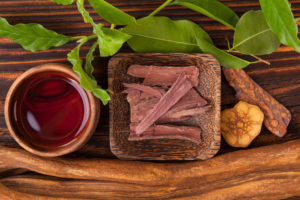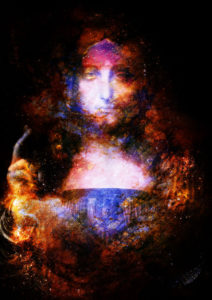Vine of the Spirits

The Hollywood Reporter described a trend emerging over the past few years in Hollywood—ayahuasca ceremonies. It appeared as part of the plot in the 2014 movie, While We Were Young, with Jennifer Aniston, Naomi Watts and Ben Stiller. The website Ranker, in “Celebrities Who have Tried Ayahuasca,” said stars like Paul Simon, Chelsea Handler, Jim Carrey, Tori Amos, Lindsay Lohan, Sting and others have taken the “yage” plunge. Described as a muddy tea, the active ingredient in ayahuasca is one of the world’s most potent psychedelics. Derived from a vine harvested in Peru and Brazil, it has been used for spiritual ceremonies for centuries and apparently it wants to be more widely used. A Hollywood psychiatrist that hosted a yage ceremony said: “The plants told them [shamans leading the ceremonies] Hollywood’s a good place to get the word out.”
Despite its faddish use today, it was originally described by 16th century Christian missionaries from Spain and Portugal who encountered South Americans using ayahuasca. The missionaries described it as “the work of the devil.” It was also sought out by William Burroughs in the early 1950s. Burroughs had hoped ayahuasca would relieve or cure his opiate addiction. His experience became the basis of a 1963 novel he co-wrote with Allen Ginsburg called The Yage Letters. Traditional use by shamans led to native religions forming around ayahuasca rituals in the 1930s. In Brazil ayahuasca has had a legal status for ritual use since 1987.
Ayahuasca is a combination of chacruna leaves and the bark of the Banisteriopsis caapi vine, or caapi. “Aya” contains DMT (dimethyltrytamine), a powerful psychedelic. It is illegal in the U.S. and classified as a Schedule 1 drug. Its acute effects last about four hours and include intense perceptual, cognitive, emotional and affective experiences. After about forty minutes the visions begin, but they are not always “Go Ask Alice-White Rabbit” experiences. An Emmy-winning television producer said:
The first thing you see is often your worst fear come to life. . . . Mine was Holocaust horror. Another time I saw a 50-foot black widow spider — my fear of death manifesting. It illuminates the dark of your subconscious, and like a horror movie, once you see it, it no longer scares you.
Other visions were less intense. One person saw what looked like a Star Wars set: “dragonflies, sparks of light, plants, stars — everything moving. You go into it asking Mother Ayahuasca a question, then she shows you what you need to know.” Another person said: “I saw a spaceship the first time, then a machine with little gears and fobs. ‘This is how the universe works,’ a woman’s voice told me. The more you do it, the less anxiety you have. It lifts us out of the isolation everyone feels, particularly in Los Angeles.” But a Hollywood internist named Gary Cohen wasn’t convinced:
Ayahuasca contains chemicals found in SSRI antidepressants like Prozac and dangerous, older MAO-inhibitor antidepressants like Parnate. There are potential serious side effects, both with other drugs and food. Foods that contain tyramine — alcohol, cheese, meat, chocolate — can theoretically interact with ayahuasca to cause severely elevated blood pressure, resulting in strokes and extremely high body temperatures, which can cause death. I strongly advise my patients against using it recreationally or ‘spiritually.’
A handful of deaths have been reported, particularly those with heart ailments and high blood pressure. An 18-year old California teen seeking spiritual rebirth in 2012 was buried at the center in the Amazon jungle where he took the drug. “His shaman was convicted of homicide and sentenced to five years in prison.” The stories of transformation tend to hook interested individuals into trying it. “The rise of festival culture, Burning Man, plus technology — it’s all making everyone desire a deeper place.”
There has been some research into the effects of Ayahuasca. A paper was published in Psychological Medicine. The researchers conducted a double-blind randomized placebo-controlled trial of 29 (14 received ayahuasca; 15 received the placebo} patients with treatment-resistant depression. They found a rapid antidepressant effect after a single dosing session with ayahuasca when compared to placebo. The authors concluded: “This study brings new evidence supporting the safety and therapeutic value of ayahuasca, dosed within an appropriate setting, to help treat depression.” The study was registered at http://clinicaltrials.gov (NCT02914769).
We found evidence of rapid antidepressant effect after a single dosing session with ayahuasca when compared with placebo. Depression severity changed significantly but differently for the ayahuasca and placebo groups. Improvements in the psychiatric scales in the ayahuasca group were significantly higher than those of the placebo group at all time points after dosing, with increasing between-group effect sizes from D1 to D7. Response rates were high for both groups at D1 [day 1] and D2 and were significantly higher in the ayahuasca group at D7. Between-groups remission rate showed a trend toward significance at D7.
I would suggest there are several issues with the study. First is the washout period of 2 weeks, meaning any patients using antidepressants were rapidly tapered off them two weeks before the study. This was to ensure antidepressant medication was no longer present in the patient’s body. However, because of the rapidness of the taper the patients will likely have experienced antidepressant discontinuation syndrome (withdrawal) and a rebound of their negative mood, confounding the assessment of depression.
This short maximum time—seven days—for assessing the antidepressant effects is another limitation of the study. Ketamine, another medication with rapid antidepressant effects and psychedelic effects, has been shown to fade rapidly and require frequent, repeated treatments. The positive effects (or evidence of fading effects) ayahuasca may have on the patients beyond seven days is not known since antidepressant treatment is resumed at that point. Then there is the context of the ceremony itself.
Neuroskeptic reviewed the study on his blog, stating it revived some long-standing questions. He did think it was a promising, well-designed study, however. One of the qualities he pointed out was how the placebo brew looked, tasted and smelt like the real thing. He noted where Palhano-Fontes et al. concluded that while no serious side effects occurred, “the ayahuasca session was not necessarily a pleasant experience.” He thought the antidepressant effects were themselves a kind of placebo response—”the ayahuasca caused powerful psychedelic effects, such as ‘altered perception’ and ‘transcendence.’”
Such potent subjective experiences could lead patients to have confidence in the treatment and thus drive placebo effects, if combined with expectations that ayahuasca will be beneficial. A profound experience could trigger improvement in other ways, as well, such as by giving patients a new perspective on their own mental state.Now, in the case of ayahuasca, this ‘psychological’ interpretation of the antidepressant effect is not necessarily a problem. I think most people (including the traditional ayahuasca users) already assume that the psychedelic experience is part of the therapeutic process.
But it does raise the possibility the positive effects are not due to the ayahuasca itself. As the researchers themselves said, ayahuasca is not a panacea.
Three of the study’s authors described their study on The Conversation. They said it was the first randomized, placebo-controlled clinical trial of ayahuasca, which means “the vine of the spirits” in the Quechua language. They began by recruiting 218 patients with depression. The twenty-nine selected for the study had treatment-resistant depression and no history of psychiatric disorders like schizophrenia, “which ayahuasca may aggravate.” Although the sessions took place in a hospital, the space used was designed like a quiet and comfortable living room.
One day afterwards, 50% of all patients were significantly improved, including reduced anxiety and improved mood. After a week, 64% of the patients who just received ayahuasca felt their depression had eased. They also noted that because ayahuasca is illegal in many countries, its therapeutic value is difficult to test. Even in Brazil, using ayahuasca to treat depression remains a fringe, informal endeavor. They cautioned that ayahuasca was not a panacea or cure for depression.
Such experiences may prove too physically and emotionally challenging for some people to use it regularly as treatment. We have also observed regular ayahuasca users who still suffer from depression.
Another of the study’s authors pointed out the media interest given to ayahuasca as a potential “cure” for addiction and depression and said maybe it is, but “it’s too soon to tell.” He cautioned against such a conclusion. Acknowledging the power of the placebo effect, he said, “It is not currently possible to conclude that the observed effects were really caused by ayahuasca, or that ayahuasca can ‘cure’ depression.” He also seemed to agree with Neuroskeptic, that the powerful psychedelic effects were a kind of placebo effect: “By helping us find the sacred within us, its psychoactive power seems to hold therapeutic potential as an alternative way to address common disorders that modern medicine has thus far found difficult to treat.” He concluded by saying we’ll have to wait and see what the science says.
For more on ayahuasca, go to: “Ayahuasca Anonymous,” Part 1 and Part 2.

